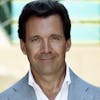Beyond Sustainable: How America's First "Carbon Positive" Hotel Shows What's Possible For The Planet (And Profits) - Jon Buerge, Urban Villages
Populus is going to be the first carbon-positive hotel in America when it opens in Denver in 2024, which basically means it leaves the planet in a better place than before it existed because it's removing carbon dioxide (C02) emissions from the air.
In this episode, we’re going behind the scenes with the developer of the incredible project, Jon Buerge of Urban Villages, to hear all about how it got started and the opportunity it presents for all of us in hospitality.
- Follow Jon on LinkedIn
- Learn more about Urban Villages
- Learn more about the Populus from Studio Gang and dezeen
Join in the conversation on this episode on the Hospitality Daily LinkedIn page here.
This episode is brought to you with support from Sojern. Finding and appealing to travelers online means getting to know them, and that's why first-party data - the information you have about your guests - is so important to providing hospitality today. I teamed up with Sojern to study how hoteliers are using this data to drive revenue and build stronger guest relationships, and you can see what we found in this research report: How Hotel Brands Are Using First-Party Data to Drive Revenue & Build Stronger.
Josiah: Populus is going to be the first carbon-positive hotel in America when it opens in Denver in 2024, which basically means it leaves the planet in a better place than before it existed because it's removing carbon dioxide, CO2 emissions from the air. In this episode, we're going behind the scenes with the developer of this incredible project to hear all about how it got started and the opportunity it presents for all of us in hospitality.
Jon: I strongly believe that the real estate industry has to play a really critical role in solving the climate challenge that we're facing as human species. And I think that hotels in particular have the biggest opportunity to convey the importance of this work.
Josiah: That's Jon Buerge, president of Urban Villages. And today we talk about the need and opportunity for sustainability and real estate development before getting into the story of the Populus Hotel. This episode is a crazy deep dive into creating a truly next generation hotel and everything that goes into it from working with the city to architecture to operations. So get out your notepad and get ready to learn with me from John in this incredible conversation.
Josiah: Tell us a little bit about your career journey to your role today, and then let's get into what you're doing.
Jon: It all starts with your childhood, right? And for me, I had the fortunate opportunity of being raised in the mountains of Colorado. And so as a young child, I would spend countless hours going on hikes in the woods and hiking up to mountain streams and being able to really experience some of the most beautiful natural ecosystems in the world. And as a child, I remember thinking, that nature was almost endless, that it was so much bigger than humanity, and that there was sort of nothing that could interfere with the expansiveness of the natural world. And that started to change when I got to college. I got to college and I started to realize that climate change was real, that environmental degradation was happening on a global scale. But even in college, I remember specifically thinking this was something that was going to affect humanity 100 years, 150 years, some future generations. I did not feel this sense of immediacy. As I got out of school and as I started working, I started to realize that there was an immediate emergency on our hands from an environmental standpoint. And so I made the career choice to go to law school. I attended Vermont Law School with the goal of working in environmental advocacy. I wanted to work for the EPA, or I wanted to work on international environmental policy. And after my first year of law school, I realized that I was part of this sort of preeminent environmental law program. And everybody that I was in school with, we're all going down the same path, we were all going to go work for the EPA, we were all going to go work on policy and politics. And really the stick, we were going to work on the regulations that was going to force change. And I started to question whether or not that's really where I could make the biggest impact. And I started questioning whether or not I could make a bigger impact by being involved in business. And rather than being on the stick side, be more on the carrot side, being trying to figure out how could you, how could the economy be a driver of change, a positive change? And so I ended up transferring schools and I transferred to the University of Colorado, and I started pursuing a joint degree with my law degree and also an MBA so that I could start to understand not only how the regulations were going to be managed, but also how does business work? How could you create a win-win scenario for business folks that could actually implement environmentally responsible practices and not be forced to by government regulations? And when I got to see you, I sat down, I had an opportunity to meet the founder of our company, Grant McCargo, who's the CEO of Urban Villages. And as I was kind of recapping my journey, he sort of thoughtfully listened to me and then he interrupted and he said, Jon, if you really truly want to make an impact, show people how to make money doing the right thing. And for me, that was kind of like the beginning. I was like, there's a kindred spirit. I feel that same way. And I know that there's a really positive path here. Why real estate, I think, is the next big question. What was it about real estate? For one, I think real estate affects all of our lives in tremendous ways. It's how cities are built, how communities are built. It can reinforce social justice. It can create financial wins for communities. So real estate has a very real impact on people's lives. And maybe more importantly, for my own personal journey, my belief is that real estate is the single largest culprit of climate change today. 40% of global greenhouse gas emissions or over 40% of global greenhouse gas emissions today come from buildings. Further, you know, over 50% of the materials we extract from our planet. So when we talk about ecological destruction, we talk about mass mining, we talk about deforestation, you know, over 50% of the materials that we take from our planet go into the built environment. And it also affects waste stream. Over 60% of the materials that we put in our landfills today are coming from construction waste. And so you cannot effectively mitigate or correct the damages of climate change without looking to the real estate industry. And that's kind of surprising. Most people look to single occupancy vehicle, mass transit, energy production, all really important aspects, but very little focus is on real estate. So for me, that's a really critical aspect. The other part of this to remember is that the issue with real estate is getting bigger. It's estimated today that the world is building the equivalent square footage of New York City every 35 days. So if you think about what that means, you know, between now and 35 days from now, we talk about late November, we will have rebuilt New York City in the world. And so when we talk about not only how are we building buildings, how are we operating buildings, how are we decommissioning buildings, it's a very critical part and it's an issue that's going to get bigger and bigger and bigger over time. And so we have to as an industry start to really think holistically about what are we doing? What is our role in solving climate change in correcting ecological destruction? How can the real estate industry do that? And I don't think that that happens through regulations alone. I think regulations are important, but I think that it has to create economic incentives. It has to be good business for developers and investors to build greener buildings, to operate greener buildings, or it will never really take off. And I think that we're at a moment in time where those pressures are converging. More and more local municipalities are putting together very strict climate regulations around buildings. Denver, where I live and work, we just passed energized Denver ordinance. It's requiring all commercial buildings in the city of Denver to be net zero energy by 2040. Seattle is another market we've worked heavily in. Same type of regulations. Boston, Chicago, most major metropolitan areas are now putting together very strict building guidelines. So there's that stick. It's coming. It's already come. And so people, the industry has to pay attention to that. What I'm so excited about though is not so much the stick, it's that carrot. Why is it make good business sense to build and operate buildings that are better for the planet? The reality is consumer demand is skyrocketing. What has happened in the last five years, let alone the last decade, is that more and more and more consumers, more and more of all of us and all of you, the listeners to this podcast are paying attention to the environment. They're paying attention to our consumption decisions and how they may positively or negatively affect the health of our planet. And so there's this real opportunity now to create a new product, to create a new way of talking about a product, to bring consumers in and create a demand. And I think that that's a very exciting moment in time. And I do believe that the industry is going to see a tremendous shift in the next decade because of the fact that it's a combination of consumer demand and regulatory pressure. If you're not, if you're in the real estate industry and you are not not only paying attention, but focusing on this aspect of our industry. I think you're being responsible as a business person.
Josiah: This is super exciting. And I think getting into the notion of talking about the why behind this, that was the goal we had recording this, right? I wonder if we can, I wonder if maybe we speak to people who hear you, hear this, this change is coming both on a carrot and stick level. There's consumer demand, but also legislation in place. But what would you say to developers that are saying, Hey, that sounds great, but I don't know if I can spend more money or time to create a sustainable hotel. Yeah. What would you, how would you address that?
Jon: Well, I'm going to address it a couple of different ways, but one kind of very near to address is the arbitrage opportunity. When you look at the Paris Accord, when that was signed, the European Union started implementation. The United States, we don't need to get into it, pulled out of the Paris Accords. And so we're quite a bit behind when it comes to the built environment and creating a greener commercial building set. But in Europe, what we have seen is that buildings that do not implement the decarbonization strategies that have ignored energy efficiency, that have ignored trying to electrify buildings, are actually creating a negative arbitrage in the value of their building. If a building is worth $10 million and there's a million dollars in renovation to electrify and decarbonize the building, What that building is worth today might be eight, $7 million. And so my point is, is that it's worth less than the cost of renovating the buildings. The same is true on the positive side. So in the European Union, on average, if you have a building that would be worth $10 million, you've implemented a million dollars of decarbonization strategy. On the other side, it may be worth $12 or $13 million. So what we're seeing is that the market is overreacting in both ways to the value of a building. So if I own a building that's worth $10 million, and I know that I've got a million dollars of work that's going to be needed to decarbonize it, to electrify it, make it more energy efficient. If I ignore that investment, and I just continue operating as I have, in the future, my building will become less valuable, even more so than the cost of the renovations. And the same thing is to be said about if you do the work, it will be worth more. So we have a great case study here in America to look at the European Union and see what this scenario that we're facing right now with regulatory pressure and consumer demands, it has a very real impact on property value. And so when I hear people in the industry that say, you know, I don't know how I can invest more money in it. I don't have the time to deal with this. To me, it is inevitable. And so if you're not doing the work, if you're not focusing on it and trying to figure out how to do it, you're going to create a devaluation in your asset over time. And that I believe we're right on the cusp of that. You can and again, by looking at your European Union in the next several years, because the combination of the regulatory pressures and the consumer demand, we're going to face a very similar pressure in the United States. And for me personally, I don't want to own a building that's not prepared for the future because it will be devalued compared to other buildings. Now, if you're working on a brand new project, let's say that you're going to build a ground up new hotel or you're taking an existing building and you're renovating it and you're doing that work already. It's irresponsible not to future proof it. Why would you build a brand new building that, you know, in the next five or 10 years, you're going to have to renovate it and electrify it and change all these things? It's irresponsible not to be paying attention to those things now. And so I would kind of flip the script and say this isn't about added costs. This is about being financial stewards. This is about doing the right thing for your asset that's going to last if it's built well, 100 plus years. So why not future proof it when you know that these changes are inevitable? Commercial buildings are going to have to be electric. It's going to go in tandem with a cleaner grid. That is the path that the world is on. So why not go through that effort now to decarbonize real estate and to prepare buildings for the future?
Josiah: John, I wonder if we could, just to give our listeners some language as we move into some examples of what this looks like, I wonder if we could do a rapid fire definition of some terms and some people may be very familiar with this stuff. Some of it might be new, but I want to make sure that everyone has language to help think about this. Maybe to start out with carbon neutral, right? I think many people know what this is, or you mentioned the net zero carbon footprint. What does that mean?
Jon: So carbon neutral is essentially a term that has been used for the operations of buildings. Climate change is all about carbon in its most simplest form, right? We're emitting more carbon than we're sequestering. And that's creating a carbon pool that is like a blanket around the planet. And more and more heat is being retained as a result. That's why we're getting warmer on average. And so it's a balance of how much carbon is in our atmosphere. Now, all sorts of things that we do, you light a fire, that releases carbon into the atmosphere. a tree sucks that carbon back out and stores it into the soil. So there's a natural flow that's constantly happening on our planet of carbon being emitted, carbon being sequestered, and it creates a balance. And that balance is what creates the consistent climate that we've experienced for thousands and thousands of years. what's happening right now is that we are emitting more and more and more carbon. Meanwhile, we're deforesting massive, the rainforest, for example, is reaching a point where it's going to be emitting more carbon than it's sequestering for the first time in history. So the problem is, is that we're releasing too much carbon. When you build a building, You release significant carbon that's called embodied carbon. That's the carbon that's emitted when you're creating your steel beams, when you're creating your concrete, when you're building the furniture, when you're transporting it to your site, when you're constructing it. That's all called your embodied carbon. And every single material we produce has a carbon footprint. Then there's an operational carbon footprint. That means that once the building is opened, you turn on the lights, that electricity is being generated in some form, and there's a carbon footprint based on the operational side of your building. When people in the industry talk about carbon neutral, it's almost exclusively focused on operational carbon. So if I own a hotel and I built it 20 years ago and I'm not even worried about the building itself, all I'm worried about is the electricity and the energy that I'm using, the carbon footprint. When I turn on the building, That has a carbon footprint and carbon neutral buildings often offset that carbon footprint of the operations through some other means. Most of the time that's buying a carbon credit. So there's these carbon markets around the world. Some group somewhere decides that they've sequestered enough carbon. They monetize that, they sell it to you, and it's just a financial transaction and you're done. You're like, I'm carbon neutral. I emitted this much carbon. I bought this carbon credit. I'm carbon neutral. So that is a term that while not always consistently defined, that's almost exclusively how it is utilized in the real estate industry. There's a lot of iterations when we start talking about carbon that I think are important to jump into. We are celebrating Populus as the first carbon positive hotel.
Josiah: Tell me what that means.
Jon: Carbon positive is our project, Populus, by being carbon positive, will sequester, will suck out of the atmosphere more carbon than it emits over the lifetime of the building. So we're not just talking about our operational carbon footprint. We're also talking about our embodied carbon footprint, our end of life carbon footprint. We are talking about the totality of this project, leaving the atmosphere, leaving the planet in a better place than we found it. So that takes a very, very different perspective. That takes a very deep understanding about how do you reduce the embodied carbon footprint of the building from the beginning? So how do you build your building to emit less carbon than would be normal? And we've done that through a variety of different things, including using for the very first time globally, a fly ash carbon, fly ash concrete alternative. We've been able to reduce the carbon footprint of the concrete in the building by nearly 40%. We've also done things like removed on-site parking. If you think about the carbon that's required to dig a giant hole in the ground and build a huge concrete and steel structure, that's a massive carbon footprint. So we've tried to do as much as we could to reduce the embodied carbon footprint. Then we have gone through a very detailed process of calculating the carbon footprint of every single material that we're putting in the building, every single steel beam, every bit of concrete, not only the materials, but what carbon are we emitting by driving it to our site, by shipping it from overseas, by building it. The entirety of that carbon footprint has been calculated in detail. So then we know what our embodied carbon footprint is. Then we started to go down this path of saying, OK, we know we've emitted carbon. How do we balance the budget? How do we sequester that same amount of carbon? And this has been a journey. We've never done this before. Nobody really in the industry has done this before. And so what we started with was carbon credits. We started looking at, you know, well, we know we've emitted about 8,000 megatons of carbon. We could go to the market and say, we need to buy 8,000 megatons of carbon credits and be done with it. And what we started to realize is that the carbon market, while an important early phase is very imperfect. There's a lot of media that's coming out on a regular basis saying, are your carbon credits really sequestering carbon or is it all just kind of a game? And it's very hard to verify it. And it's also hard to even know exactly where the carbon is being sequestered. And it's also often about a mechanical solution. And for us, we saw that and we said, well, that's not exactly what we want to do. We really want to be able to do this in a way in which we can identify how we can identify the source. We can potentially use this investment to strengthen ecology, maybe even build partnerships within our communities. And so we started looking at nature-based carbon sequestration strategies that we could then invest in directly. That led us to a partnership with the US Forest Service. So far, we've already planted about 75,000 trees here in Colorado. And we even went further than saying, we're going to plant trees because each tree is going to sequester carbon into the soil. But we also said, well, where, where should we do this? And how should we do this? One solution is you go and plant a bunch of palm trees in the Amazon. Technically, is it sequestering carbon? Sure. But it's also a monoculture crop that doesn't restore an ecosystem. Here in Colorado, we've been decimated over the last couple of decades by Japanese beetle kill. These non-local beetles were introduced to our ecology. And because the trees and the forest in our area were not used to these beetles, it ended up killing mass amounts of a dominant tree species in our forests. And so we were able to partner with the U.S. Forest Service to basically identify a Japanese beetle-resistant spruce alternative. It's called the Engelmann spruce, and go into a beetle-killed decimated forest and replant that dominant tree species. So not only are we sequestering the carbon that we've emitted, but we're also rebuilding a really important ecosystem that is diverse and that is a part of a broader system versus being one single tree that we're planting as a one-off. When I said that we're carbon positive through the entire life cycle of the building, all we've solved so far is the corn shell of the building. We've planted those 75,000 trees to offset all the carbon we've emitted through the steel and concrete and transportation to build the building. We're right now calculating the carbon footprint of every piece of furniture, every piece of art, every piece of every speaker, every material that goes into the building beyond the corn shell. Once we have that calculated, we're going to go through the same effort of saying we need to plant this many trees or we need to do this other sequestration strategy to offset that carbon footprint. And then once we open, that's an ongoing tally. That is a calculation. Every three months, every fiscal quarter, we're going to be recalculating how much energy have we used, how much food have we brought through the building, how much waste have we brought to the landfill and evaluate the carbon footprint of every single thing that flows through the building. And then on a quarterly basis, reinvest in new nature-based sequestration strategies so that we are continually ahead of the curve. We're continually sequestering more carbon than we are emitting. And what's exciting is that this is, there's a lot of options. It's not just through planting trees. That's been the first phase for us because we saw that as an immediate need that could rebuild a very important ecosystem. But right now we're working with a group of sustainable no-till ranching and farming operations. One of the problems with nature-based, let's look at agriculture, when you go through and till the land, plants, vegetables, trees, they all suck carbon out of the atmosphere and store it in the soil. Really positive. The problem is when you till that soil, it releases the carbon back up in the atmosphere. So all that work that plants and trees and everything have done to suck the carbon out gets re-released into the atmosphere. And so by working with no-till farming operations and ranching operations, you're able to not only keep the carbon sequestered in the soil, but also rebuild heavier and heavier soil bases, which is great for food. It's great for nutrition. It's great for the nutritional value of the food that we're growing. And so by working with these operations, there's the opportunity to not only actually sequester the carbon that we've emitted, which is our primary goal, but it's also building a strong relationship with a sustainable farming and ranching operation, which can then provide the food that we're serving in our restaurants. And so it's this circular economy. It's this way of being able to invest with a responsible operator who's trying to do the right thing for their product, sequestering the soil, and then also providing healthier food and more natural food to the guests of our hotel. So it's a very holistic way of thinking about our impact on the planet, not just about energy or not just about carbon in itself, but about doing it the right way.
Josiah: It seems this is definitely a team sport. There's a lot of players involved to pull this off. And I want to talk about that, but I do want to ask a follow up question. It seems that you are extremely thoughtful around every stage of the process here of thinking about calculating carbon impacts, everything from transportation of the products to the furniture, all this kind of stuff. How do you go about that? Is there a firm or a technology or process that you use? Because that seems extremely involved.
Jon: Well, it is. And we were actually just talking about this the other day in an internal meeting. It's really hard where we're at because there aren't a lot of consultants that are long-term experts. You know, if I want to build a building and I'm trying to figure out how to structurally design it, I can talk to a structural engineer who's done it for 30 years and knows all the answers. And I can trust that they know what they're doing. With this field, it's an emerging field. It's a field that is continuing to mature and continue to build more data. And so there are not a lot of consultants that you can just go out and hire and say, Hey, I want to do this. Tell me how to do it. Because it's emerging, right? I mean, there's a lot of different ways of going about it. And so I would say that the key is not necessarily in finding a one fit. all solution. It's about having a multitude of conversations, reading up on it, trying to like deeply understand it as a team, because then you can apply different things to different areas. You know, there, there's all sorts of great documentaries. I've been talking about the agriculture. I watched a documentary a couple years ago called Kiss the Ground, totally changed my perspective of no till farming and a, in a very real way to combat climate change through the way that we grow our food. And so once you, you gather that information, you can start to explore this with the right kind of groups to be able to come up with the right answers. You know, we know, I mentioned earlier that this is a journey. I know that five, 10 years from now, I'm going to look back at Populous and kind of chuckle at some of the mistakes we made and think like, man, we, why did we do that? That didn't make any sense. I know that that's going to be the case because it's an emerging idea. It's an emerging industry. And so we have to be willing to, to make the best decisions we know now. with the information we have, with thoughtful analytics, and to be able to really process it and try to do it the right way, but continually learning about it. I mean, there are things that already, these buildings take years and years to get built. We're going to be finishing Populous early next year. We started this process six years ago. So there are even decisions we made six years ago that now I'm thinking, gosh, I wish we hadn't done that. But it's already done. So we're going to learn from it. We're going to try to apply it to the next project. And that's that journey. And so I think that the long-winded way of answering your question is it's complicated. There is no one-stop shop to be able to get the answers that you need. But it's about going down that journey with an open mind and trying to explore and trying to really ask the question, What is the impact that our building is making on the planet, both positive and negative? And are there ways to reduce the negative impacts and truly try to leave the planet in a better place than we found it?
Josiah: Yeah. Well, I mean, the best way to make no mistakes is to do nothing at all, right? And you've laid out the case for why we need change. And you've been working at this for a while and you're driving innovation. As you mentioned, Populus is opening early next year in 2024. We're recording this late 2023. I wonder if you could take us back six years. This has been in flight for a number of years, maybe even before that. to the origins of the project. How did this all get started? Because I'm hearing from you, even as you're talking about specific elements of this, it sounds like a lot of conversations, a lot of teamwork, a lot of different organizations involved. But how did this whole project, how did the populace start out?
Jon: Well, I might even go a little bit further back than when the project started, because I think it'll give you a runway into where our minds were when we started this process. In 2008, we completed a project called West Village. It was a partnership with the University of California. And our goal on that project was to be 100% renewable energy and net zero energy. And we were able to achieve that. We house over 2,000 students, generate 100% of our electricity through onsite renewable. And that project still today, from what we understand, is the largest net zero energy project in the United States. That project was transformative. It was bold. It was exciting. It made a big impact. And I think it showed people that net zero energy, especially at a bigger scale like that is possible, practical and financially successful. After we completed that project, we started to really think about what is the overall impact of that project and others on the planet. Part of it is energy. So I don't want to say that energy is not a critical component of it, but theoretically, if your building is 100% electric and 100% of the electric is being generated through renewables, energy efficiency and stuff shouldn't matter, right? Because you're using energy that's plentiful and that can go on forever. So theoretically, net zero energy is kind of like, okay, well, we solved energy. But when you start to really dig deeper and say, well, okay, what's the ecological footprint of all those solar panels? when we're talking about batteries and we're talking about the precious metals, well, where are those metals are being mined from? And what does that do for the planet? Where is all the lumber that we're using to build these buildings or the steel or the concrete or the whatever it is? You know, just because that project's net zero energy does not mean that it did not negatively impact the planet. And so that started to make us think, well, maybe we're not thinking about this broadly enough. We need to really think about if we build a building or we renovate a building, what is the overall impact on the planet of the work we're doing? And we realized that energy is only a component of it. It's an important component, but it's only a component. I would even say not even the dominant component of the impact that real estate has on the planet. And so this was our kind of mindset as we were going into this process. This particular site where Populus is being built was owned by the city of Denver. And it is right on a central park in Denver called the Civic Center Park. It's really where Denver started. It's where the state capitol, it's where City Hall, it's where the Denver Art Museum, it's where the public library, it's where all the major city functions and state functions are centered around. And the city was looking at this one piece of property and saying, you know what, we should consider selling this to a developer with the goal of creating a different kind of activation. We don't want just a bunch of government buildings. We want to start activating the park. And so they went through and did a competitive RFP request for proposals to developers. They received 11 proposals. We were one of them. And our approach was we're going to design something architecturally stunning. Some of the most amazing architectural buildings in the state of Colorado are our neighbors. We're going to do something in suit. So we said we're going to design an extraordinary building by an architect that's never done anything in Colorado to create some architectural diversity. We're going to do something that is vibrant and exciting and creates activation and sort of helps to really invigorate the park. And we're going to do something that is completely transformative from an environmental standpoint. So those were our goals. Ironically, we were one of the lowest bids from a price standpoint, but the mayor and city council and the planning department ultimately selected us because their goal was not just to create the highest value in the land, but to create something truly transformative for that area. And so we were selected. And as we got selected by the city, we started to think about, OK, well, how are we going to do this? And we started looking at the history of the site. When we acquired it, there was a single story building on site. It was an office building for the city. And as we started to look over time, we found a really interesting historic aspect of the property. It was actually the location of the very first gas station in the state of Colorado. So there's some irony there, right? We're like, OK, well, we're talking about a piece of property that was the very beginning of single occupancy vehicles and combustion engine and all that. And we thought, well, maybe there's some fun irony here. Maybe we could do something that's kind of flying in the face of this fact that this was such a monumental moment in time for that period. And so we started to say, well, what if we built a hotel on the site and we had no parking? You know, we're right across the street from the biggest mass transit center in Colorado. So what if we just completely embrace this multimodal mass transit approach and totally take parking off site? And so then that kind of stirred this beginning of this exploration of saying, like, well, maybe we just continue to lean in on this idea that what started as the first gas station in Colorado kind of flies in the face of everything that's happened in 100 years since then.
Josiah: I love that kind of the contrast there. But what was it about a hotel? What was the significance of that? You've worked on a whole bunch of different projects. I'm sure the city was looking at a whole bunch of options. What was the opportunity there with the hotel?
Jon: Well, I think for us, there's so many incredible reasons to come to Civic Center Park. There's the Denver Art Museum, which gets over a million visitors a year. There's the State Capitol, which is a wonderful building to tour. There's City Hall. There is the Denver Public Library. There's all these incredible places to visit. And, and the park itself is quiet and sleepy, especially at night. It's sort of everything vacates. The site is also two blocks from the Denver Convention Center, so a big driver for hospitality demand. And again, when we first made our proposal to the city, we said, we're going to do something that's active. We're going to do something that's creating a reason to be at the park 24 hours a day. And so we really started to say, well, you know what? Hospitality is where we can meet those And, you know, it's where we can get the most people flowing through the building. We can create some great dynamic restaurants. So you can really start to change the feel and start to really bridge. You know, we're right on the edge of the central business district and on the other side of the park is Golden Triangle. It's, it's really very quickly becoming the densest residential neighborhood in Denver. And so we thought this is a way, hospitality is a great way to bridge that gap. and to create this activation on the park. And so we started leaning in on hospitality. The other thing I would say is our mission is to build the greenest buildings possible that are financially viable. And we've built office buildings, we've built student housing, we've built multifamily apartment buildings, we've built hotels. One thing that's really compelling about hotels is the fact that they get such heightened exposure over every other type of real estate. So if I build the greenest apartment building in the world, yeah, it makes a big impact, but it's only those hundred residents or whatever that live there for a whole year, they get to experience that and they get to really understand why that building makes an impact. With a hotel, every night, there's a new audience. There's a new audience that can experience what sustainability really deeply means, that can experience how their decisions, how their consumption decisions can make an immediate impact on the health of the planet. So the ability to be able to have two full-service restaurants, to be able to have co-working and event space, to be able to have 265 rooms that people are gonna be flowing through constantly, we have an opportunity to be able to tell this story 500 times a day to new people. And in a fun and an exciting way that's not guilt-driven, that's exciting. You know, one of our goals is that when you stay at this hotel, that you're excited about it, that you're having a, we're not gonna guilt you. Yeah, you're gonna have a carbon footprint in traveling to Denver and staying at the hotel and eating a meal at the restaurant, but we're gonna offset your carbon footprint in fun and kind of jovial ways that make you feel a part of it. And hopefully you leave that experience being like, God, you know, my stay, I just left the planet in a better place than I found it by choosing to stay at this hotel. And you may go back to your hometown and start to talk about that experience. And then maybe other hotel developers start to do that or other apartment developers start to see that there's more and more and more consumers that experience this and say, this is a really cool way of thinking about buildings. I want more of it. And then that will just continue to grow and create more and more of an impact. And so hospitality is a big, big driver of the messaging, of the experience to be able to get more and more exposure. It's kind of like, in a way, it's like the megaphone of the real estate industry. It's the place in which more and more people can get exposed to the buildings that we all build.
Josiah: You articulated a very compelling case for hospitality. I think everything from it being a benefit to the city, the people that live there. You talk about being a neighbor to so many people living in these big apartment buildings, a neighbor to everyone working in these offices, everyone who's visiting. It's a way to introduce people to new ways of operating a business. It's so powerful and such a hub and such an inspiration, I think, to people. who live in Denver, people who will visit Denver. But take us back to six years ago, you talked about this opportunity, no parking garage. Who are some of the other players that were involved there in the early days to get this going?
Jon: It really started for us as a design journey. And one of the promises we made to the city of Denver in acquiring this site was that we were going to design something that was going to be extraordinary. I mean, we're right next door to City Hall. We're right across the park. I mean, you walk out of the state capitol building, you look right at this building. So we had this this real sense of duty to create to design a building that was going to be extraordinary. And we also have some of the sort of icons of architecture of design these buildings around us. And we wanted to create diversity. We didn't want to copy. what was there. So we really felt it was important to introduce a new architect, a new way of thinking about design to the Civic Center Park and to Colorado. And so one of our goals was to bring somebody in that has never done anything in Colorado. And so we went through an international search. We interviewed about eight different architects from around the world. none of which had ever done a building in Colorado, and met with some great minds, got some really neat ideas of how we could do this, very focused on biophilia, or looking to nature to inspire the built form, biophilic design. So we really focused on how could nature be brought into this, especially with our sustainability goals. We really thought, let's look to nature for inspiration. And so we met with some incredible design minds from around the world, And when we met with Jeannie Gang and her firm, Studio Gang, for the first time, they've become more prominent over the years since we've been working with them. They were kind of at the beginning of that climb when we first met with them. And we walked in and Jeannie Gang is, is just such a, a wonderful, welcoming, humble personality. And she started walking around and talking about how she thought about design. And then we, we walked into her office and her office was really void of technology. It was, it was just this sort of a very beautiful and simple space. with a beautiful, large wood historic table in the middle of it. And there were birds nests all over the table. And immediately, we're like, that's kind of odd. What's going on with these birds nests? And she started to explain that she has been studying birds nests from different species in different climates. to try to understand how birds engineer their nests based on the climate in which they're building. And so trying to really, truly, deeply understand how birds who have evolved over millions and millions of years have learned to adapt to the climate of their particular ecosystem. And I can tell you, I was almost sold at that moment. I was like, wow, the way that this woman thinks is just mind-blowing and just very synergistic with what our goals were. And beyond that, we saw the building she had designed, just extraordinary. buildings and really also thoughtful about not creating just massive forms and things that were expensive to build. But her thought was, if it doesn't get built, why are we designing it? And so she also had a very true sense of, it's got to be buildable. It's got to be financially viable. I can't just design some crazy thing that a government is going to subsidize. It has to be buildable. And so We love that idea. She didn't pitch any specific design or anything like that. It was just really getting to know her. And so we hired her and she had never done anything in Colorado. So we were, we were kind of like, all right, well, how do we start? And she said, I've never done anything in Colorado. I need to, I need to learn about Colorado. I need to understand more about your ecology. I need to understand what Colorado is all about. And so there was several months where we weren't looking at building forms. Most of the time when you work with an architect, they kind of look at the zoning, they look at the plot of land, they figure out what the neighboring properties look like, and they start showing you different forms right away. This process started with a hike in the woods. I mean, Jeannie literally showed up with hiking boots and disappeared into the natural world of Colorado. and came back a week later and sat down and put a photograph on the table of a grove of aspen trees and said, that's my inspiration. And we're kind of like, huh, okay, how's this going to work out? And it kind of evolved from there. And she started to focus in on what are called aspen eyes. It's the scars of an aspen tree as As an aspen tree grows, it drops its branches, and it creates these really kind of unusually shaped scars on the bark of the tree. And she said, I want to use that geometry to frame the experience of somebody inside the building looking out, looking out of the mountains, looking out at the state capitol. I want to use these shapes to kind of frame the experience from inside the building. So Populous was actually designed from the inside out. It wasn't designed as like, well, this is what I want the building to look like. And then chapter two, I'm going to try to figure out how to make it work from the inside. It was actually designed all around a window and what that would experience, what that experience would be like from the inside of the building. And then that evolved to really a pretty remarkable and beautiful building that is eye-catching. I mean, you see it in the rendering form and it's like, is that really what that's going to look like? And it is. I mean, as it's coming together, it's going to look like those renderings. It's going to be truly eye-catching. And I believe when people walk out of the State Capitol and stand at those steps and look out at the range of mountains and look across Civic Center Park, their eyes are not going to necessarily go to the City Hall, it's going to go to populous. It's going to be an absolutely eye-catching and remarkable building. But the functionality of it, the way that it's been every space, the interior, the exterior, how it's all come together is really remarkable. And I think that even though it's eye-catching from an architectural standpoint, I think the true success, the true beauty of this building is how the occupants of the building are going to experience it, and just be engulfed by this absolute adoration, this absolute reverence for nature. And even the name, we call it populace, and it's not populist, which is probably what a lot of people think when they hear it. It's actually populace, which is the first word in populist tromeloidus, which is the Latin term for grove of aspen trees. And so the name is also, and the brand is engulfing this idea of what I would argue is probably the most iconic natural element in the state of Colorado, in the Rocky Mountains, which is the Aspen tree. And all that that means to Coloradans and all that means to nature enthusiasts, it's a truly remarkable species. And to be able to bring that into an urban setting and into a building in a way that's not kitschy and not like, you know, kind of weird is actually really, really hard. And I think it's Jeannie and her team have done it in a really remarkable way.
Josiah: Also hats off to you and your team. I think I'm hearing this is definitely a team sport, but hearing your own story, everything from your childhood to your career journey, to the team and the collaborators that you assembled to pull this project off, what a project, what an inspiration. I can't wait to visit it when it opens up. I'm really excited. I'll link in the show notes to where people can find more about this hotel, about yourself, about your firm. But I guess before we go, any closing thoughts or calls to action that you would have for those that are listening to this? It might be developers, investors, it could just be people working in the hospitality industry. What would you like them to be thinking about as they, you know, coming off of hearing your story and heading into the rest of their day, rest of their week?
Jon: You know, I think the key is we started this conversation, Josiah, with this idea of a lot of developers start this discussion or start this journey with like, how can I afford this? How can I take the time? How can I, you know, it's hard to make a building financially viable today with the economic conditions. How in the world could I add additional cost burden on my project? And I believe that when people get to that state of mind, they're not thinking about the opportunity. They're not thinking about the challenge the right way. Populus is going to be financially very successful. We don't do projects that are subsidized. We're not getting grants. We're not we don't have nonprofit investors. We have to hit market returns. And our projects do. And often they exceed market returns. And Populus is no different. So just because of the fact that we're driven, for the most part, like our firm are a bunch of environmentalists. That's really what motivates us. That's what drives us. But we know we can't keep doing this. If we're not returning the appropriate investment returns, our investors have to see that this makes good business sense. And so what's critical, I think, and I hope all of your listeners take this away from Populous, Populous is going to be financially lucrative. And I have no shame in that. None of us have any shame in that. This is why we do it. And our investors are going to be very, very happy with this hotel. And I think that that's an important metric that we constantly try to talk about. We embrace that challenge. And I think that anybody that's focused on this, that if you look at it with the right, the right goals, the right perspective, and you think creatively that almost any product type in almost any market is it's financially justifiable, if not even encouraged from an investment perspective to do something that's better for the environment. And it's also critical to not feel like you're burdened to do everything. I've had some people say, well, why didn't you do this? Well, why didn't you do that? I mean, part of it is because maybe we didn't have that idea or we didn't think about it, or we didn't know about that at that point, but it's also about a decision. You can't do everything. If you try to do everything, your project will never get out of the ground. And so it's about trying to understand where you can have the biggest impact, the biggest bang for the buck, where you can really start to lean in on certain aspects of it and be okay with the fact that it's not going to be perfect every time. You can compromise in some areas, so long as on the net you're doing something that's better for the planet and you're pushing the industry in the right way. And I think Populus is an example where people will see it and, yeah, it's not perfect. You're going to be able to pick out details. You're going to be able to find things that we could have done better. But ultimately, I believe Populus is going to be a transformative project that's going to change the industry, and it's going to be a financially successful project. And to me, that's a win.
Josiah: Well, congratulations for what you have done, Jon, with your team. Really excited about this property and this project opening up. But I appreciate you taking time to share the story behind it. I'm very inspired listening to you, and I know our listeners will as well.
Jon: I so appreciate it. And thank you for having the conversation.

Jon Buerge
President of Urban Villages
Jon Buerge is the President of Urban Villages, a leading real estate developer and environmental steward, where he is responsible for all development activities, new company acquisitions, corporate growth, and strategic positioning of all real estate assets. A seasoned leader with two decades of real estate development experience – over 15 years of which have been spent at Urban Villages – Buerge’s expertise spans across real estate, investment management, land regulations, market analysis, construction law, due diligence, development, and property management, among many others.
At his core, Buerge is an environmentalist and is fiercely passionate about positively impacting our planet through his work. He serves as a board of director on the Downtown Denver Partnership and the Urban Land Institute (ULI).
Most Popular Episodes
Check these out:























